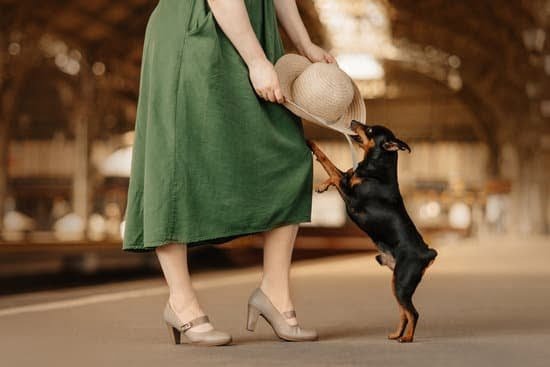Are you looking for an effective and humane way to train your furry friend? Look no further than the click stick. In this article, we will explore how to use a click stick for dog training, covering everything from the basics of clicker training to advanced techniques and real-life success stories. Whether you’re a first-time pet owner or a seasoned trainer, incorporating a click stick into your dog training routine can bring about remarkable results.
Clicker training is a popular and positive reinforcement-based method that has been proven to be highly effective in teaching dogs new behaviors. The key to successful clicker training lies in understanding the principles behind it and choosing the right click stick for your dog’s specific needs. With our step-by-step guide, you’ll learn how to use a click stick for basic commands, as well as troubleshoot common issues that may arise during training sessions.
Furthermore, we will delve into advanced click stick techniques for more complex commands and behaviors, as well as how to tailor click stick training to different breeds and personalities. By the end of this article, you’ll have a comprehensive understanding of the benefits of using a click stick for dog training, along with inspiring success stories that showcase just how effective this method can be.
So, grab your click stick and get ready to embark on an exciting journey towards better communication and obedience with your canine companion.
Understanding the Basics of Clicker Training
Clicker training is a positive reinforcement method that uses a click sound to communicate to your dog that they have performed the desired behavior. This method is based on the principles of operant conditioning, where the dog learns to associate the click with a reward, such as a treat or praise. The clicker acts as a bridge between the desired behavior and the reward, making it an effective and efficient training tool.
To start using a click stick for dog training, you will need to first introduce your dog to the click sound and establish its meaning. This can be done by simply clicking the stick and immediately giving your dog a treat. Repeat this several times until your dog starts to understand that the click is associated with something positive. It’s important to keep training sessions short and fun to maintain your dog’s interest and enthusiasm.
Once your dog has made the association between the click sound and getting a reward, you can start using the click stick to train specific behaviors or commands. Timing is crucial when using a clicker, as you want to ensure that you click at the exact moment your dog performs the desired behavior.
Consistency is also key, so make sure to always follow up with a reward after clicking, and gradually phase out treats as your dog becomes more proficient in their training.
Here are some basic steps for how to use a click stick for dog training:
- Hold the click stick in one hand and have treats ready in the other hand.
- Wait for your dog to perform the desired behavior.
- As soon as they do, click the stick.
- Immediately give them a treat.
- Repeat this process multiple times until your dog consistently responds to the click by performing the desired behavior.
Using these simple steps can help lay down a solid foundation for using a click stick effectively in training your furry friend.
| Click Stick Training Steps | Description |
|---|---|
| Introduce Click Sound | Start by associating the click sound with something positive through consistent rewards. |
| Timing is Crucial | Always make sure to click at exactly when your dog performs the desired behavior. |
| Consistency | Follow up with a treat every time you use the click stick, gradually phasing out treats as they become more proficient. |
Choosing the Right Click Stick for Your Dog
When it comes to dog training, using a click stick can be a powerful tool to help shape your dog’s behavior. However, not all click sticks are created equal, and it’s important to choose the right one for your dog.
The first thing to consider when selecting a click stick is the size of your dog. For smaller breeds, a smaller and quieter click stick may be more appropriate, while larger breeds may require a louder and sturdier click stick.
Another factor to consider is the ease of use of the click stick. Some click sticks come with ergonomic handles or wrist straps, which can make them more comfortable to hold during training sessions. Additionally, consider the durability of the click stick. Look for a click stick that is made of high-quality materials and can withstand being dropped or stepped on during training.
It’s also essential to choose a click stick with a distinct and consistent clicking sound. This will make it easier for your dog to associate the sound with positive reinforcement. Remember that consistency is key in dog training, so finding a reliable click stick that produces the same sound every time is crucial.
| Factor | Consideration |
|---|---|
| Size of Dog | Smaller breeds may require a quieter click stick |
| Ease of Use | Look for ergonomic handles or wrist straps |
| Durability | Choose a high-quality and sturdy material |
| Consistent Sound | Find a click stick that produces the same sound every time |
By considering these factors and choosing the right click stick for your dog, you can set yourself up for success in using this valuable tool for training purposes.
Step-by-Step Guide on Using a Click Stick for Basic Commands
When it comes to training your dog, using a click stick can be an effective tool to reinforce positive behavior and teach basic commands. Here is a step-by-step guide on how to use a click stick for basic commands:
1. Introduce the Click Stick: Before you begin training, introduce the click stick to your dog. Allow them to sniff and become accustomed to the sound of the click. This will help them associate the sound with positive reinforcement.
2. Start with Basic Commands: Begin with simple commands such as “sit” or “stay.” When your dog performs the desired behavior, immediately click the stick and follow it up with a treat. This will create an association between the click and getting rewarded.
3. Consistency is Key: Be consistent with your timing when using the click stick. The moment your dog performs the command correctly, click and reward. This clear signal will help your dog understand what behavior is being reinforced.
4. Gradually Phase Out Treats: As your dog becomes more familiar with the click stick and consistently responds to basic commands, you can start to phase out treats and rely solely on the clicking sound as positive reinforcement.
5. Practice Patience and Persistence: Training takes time, so be patient with your dog as they learn to respond to the click stick. Consistent practice and repetition will help solidify their understanding of the commands.
Using a click stick for dog training can be highly effective in teaching basic commands and shaping good behavior in your furry friend. With patience, consistency, and positive reinforcement, you can successfully train your dog using this method.
Advanced Click Stick Techniques for Dog Training
Once you have mastered the basics of using a click stick for dog training, you can move on to more advanced techniques that will help further develop your dog’s obedience and skills. Advanced click stick techniques involve using the clicker for more complex commands and behaviors, as well as refining and perfecting the ones your dog already knows.
One advanced technique is called “shaping,” which involves breaking down a desired behavior into smaller steps and reinforcing each one with a click and a treat. For example, if you want your dog to learn to pick up his toys and put them in a basket, you would start by clicking and rewarding him for simply touching the toy, then for picking it up, then for carrying it towards the basket, and finally for dropping it inside.
This method requires patience and precision but can lead to impressive results.
Another advanced technique is known as “backchaining,” which involves teaching your dog a series of behaviors in reverse order. This is particularly useful for complex tricks or obedience competitions where the dog needs to perform a sequence of actions. By starting with the last behavior in the sequence and working backwards, you can ensure that your dog understands each step thoroughly before moving on to the next.
One important aspect of advanced click stick training is timing. As the behaviors become more complex, it becomes even more crucial to click at exactly the right moment to capture the desired action. Consistency is key in this stage of training, so be sure to practice precise timing with your clicks.
Additionally, incorporating variable reinforcement schedules can help maintain learned behaviors while introducing new ones. With dedication and practice, these advanced click stick techniques can take your dog’s training to an impressive level of skill and responsiveness.
Overall, advanced click stick techniques require patience, precision, and consistency in order to be effective. By utilizing shaping, backchaining, precise timing,and variable reinforcement schedules,you can further enhance your furry friend’s learning experience,and progress their skills beyond basic commands.
Troubleshooting Common Click Stick Training Issues
Using a click stick for dog training can be an effective and positive way to teach your furry friend new behaviors. However, like any training method, there may be some common issues that arise. Here are some troubleshooting tips for common click stick training issues:
1. Inconsistent Timing: One of the most important aspects of clicker training is timing. If you find that your dog is not responding as expected, it may be due to inconsistent timing when clicking the stick. Make sure to click at the exact moment your dog performs the desired behavior, followed by a reward.
2. Lack of Motivation: If your dog seems uninterested or unmotivated during click stick training, it could be because the rewards you are using are not enticing enough. Consider using high-value treats or toys to increase motivation and excitement during training sessions.
3. Overuse of the Click Stick: Using the click stick too frequently or in inappropriate situations can confuse your dog and diminish its effectiveness. Reserve the click stick for specific behaviors you want to reinforce and avoid clicking randomly or excessively.
Remember, patience and consistency are key when using a click stick for dog training. By troubleshooting common issues and adapting your approach, you can improve the effectiveness of this positive reinforcement method and strengthen the bond with your beloved pet.
We hope these troubleshooting tips help you address any challenges you may encounter while using a click stick for dog training.
Click Stick Training for Different Breeds and Personalities
Understanding Your Dog’s Breed and Personality
Before using a click stick for dog training, it’s important to understand that different dog breeds have unique characteristics and personalities. For example, some breeds may be more energetic and require high-intensity training, while others may be more independent and need a different approach.
Additionally, individual dogs within the same breed may have different temperaments and learning styles. Understanding your dog’s breed and personality is crucial in tailoring the click stick training to effectively communicate with your furry companion.
Customizing Click Stick Training for Different Breeds
Once you have identified your dog’s breed and personality traits, you can customize the click stick training approach accordingly. For example, if you have a high-energy breed like a Border Collie or a Labrador Retriever, you may need to incorporate more physical activity into the training sessions to keep them engaged.
On the other hand, if you have a more laid-back breed such as a Basset Hound or a Bulldog, you may need to adjust the pace of the training to match their temperament. Customizing click stick training for different breeds involves adapting the timing of clicks, the type of rewards used, and the intensity of the commands based on what works best for your dog.
Personalized Approach for Individual Personalities
In addition to considering your dog’s breed, it’s essential to personalize the click stick training for their individual personalities. Some dogs may be highly motivated by food rewards, while others may respond better to playtime or verbal praise.
By observing your dog’s reactions during training and adjusting your methods accordingly, you can create a personalized approach that resonates with their unique personality. This personalized approach not only enhances the effectiveness of click stick training but also strengthens the bond between you and your four-legged friend.
The Benefits of Using a Click Stick for Dog Training
Using a click stick for dog training offers a wide range of benefits for both the dog and the trainer. One of the main advantages is that it provides a consistent and clear way to communicate with your dog during training sessions. The clicking sound acts as a marker to let your dog know when they have performed the desired behavior, making it easier for them to understand what is expected of them.
Another benefit of using a click stick for dog training is that it allows for precise timing when marking your dog’s good behavior. This precision is essential in reinforcing positive behaviors and helps your dog learn more quickly and effectively. It also helps in reducing confusion for your pet by clearly indicating the exact moment they did something right.
In addition, using a click stick can help build a strong bond between you and your furry friend. Since clicker training relies on positive reinforcement, it creates a supportive and trusting relationship between you and your dog based on encouragement rather than punishment. This method emphasizes rewards for good behavior, which can lead to increased motivation and willingness to learn from your pet’s side.
Overall, incorporating the use of a click stick into your dog training routine offers numerous benefits that can contribute to successful, efficient, and enjoyable training sessions with your furry companion. By utilizing this tool properly, you can enhance communication with your pet, improve their learning experience, and strengthen the bond you share while achieving positive results in their behavior.
Real-Life Success Stories of Click Stick Training
Turning a Problem Dog Into a Well-Behaved Pooch
One success story of using a click stick for dog training involves a dog named Max. Max was known for his unruly behavior and disobedience to basic commands. His owner, Sarah, was at her wits’ end until she decided to try click stick training.
With consistent use of the click stick combined with positive reinforcement, Max began to respond to commands such as sit, stay, and come. Over time, Sarah noticed a significant improvement in Max’s behavior, and he transformed from a problem dog into a well-behaved pooch.
Helping Shy Dogs Gain Confidence
Another success story comes from an owner who used click stick training to help their shy and anxious dog gain confidence. By utilizing the click stick along with treats and praise, the owner was able to gradually expose the dog to new experiences and environments. Through this method, the once-shy dog became more outgoing and less fearful. The use of the click stick played a crucial role in helping the dog build trust and overcome its anxiety.
Enhancing Competitions Skills
For owners who participate in canine competitions such as agility or obedience trials, using a click stick for training has proven to be effective in enhancing their dogs’ skills. By incorporating the clicker as part of their training regimen, many handlers have seen improvements in their dogs’ performance during competitions. The precise timing of the click stick helps reinforce specific behaviors or actions, leading to better focus and execution from the dogs during these high-pressure situations.
Real-life success stories like these demonstrate just how effective using a click stick for dog training can be in transforming problematic behaviors, building confidence, and honing competition skills in dogs. These heartwarming stories serve as inspiration for other dog owners who may be struggling with obedience or behavioral issues with their pets.
Conclusion
In conclusion, utilizing a click stick for dog training can be an incredibly effective and efficient method for teaching your furry friend new commands and behaviors. As discussed in this article, clicker training provides a clear and precise way to communicate with your dog, helping to reinforce positive actions and discourage negative ones.
By understanding the basics of clicker training and choosing the right click stick for your dog, you can start implementing this technique to achieve impressive results in no time.
The step-by-step guide on using a click stick for basic commands provides a helpful roadmap for beginners looking to incorporate this method into their training routine. Additionally, the advanced techniques highlighted in this article offer more experienced trainers the opportunity to take their dog’s skills to the next level. Despite potential challenges that may arise, troubleshooting common issues and tailoring click stick training to different breeds and personalities can help ensure success in your efforts.
Ultimately, the benefits of using a click stick for dog training are vast. From increased communication between you and your pet to the ability to shape specific behaviors, clicker training has proven time and again to be a valuable tool for both professional trainers and at-home pet owners alike.
Real-life success stories further emphasize just how impactful this method can be in transforming unruly or disobedient dogs into well-behaved companions. As such, it’s clear that incorporating a click stick into your dog training regimen is a decision that can yield long-lasting positive outcomes for both you and your four-legged friend.
Frequently Asked Questions
How Do I Use a Clicker to Train My Dog?
Using a clicker to train your dog involves creating an association between the sound of the click and a reward, such as a treat or praise. When your dog performs a desired behavior, you immediately click and then give them the treat. This helps them understand that the behavior is what earned them the reward.
How Do You Use a Click Stick?
A click stick works similarly to a traditional clicker in dog training. It consists of a retractable stick with a clicking device at one end.
The process of using it to train a dog involves extending the stick to direct the dog into position or to perform specific actions, then clicking to signal that they’ve done what was asked before rewarding them.
Is a Clicker Good for Dog Training?
Clickers are generally considered effective tools for dog training because they provide immediate feedback to the dog, helping them understand exactly which behavior is being rewarded. That said, like any tool, its effectiveness depends on how it’s used and whether it’s paired with consistent positive reinforcement techniques.
Some dogs respond very well to clicker training while others may not find it as motivating.

Welcome to the blog! I am a professional dog trainer and have been working with dogs for many years. In this blog, I will be discussing various topics related to dog training, including tips, tricks, and advice. I hope you find this information helpful and informative. Thanks for reading!





